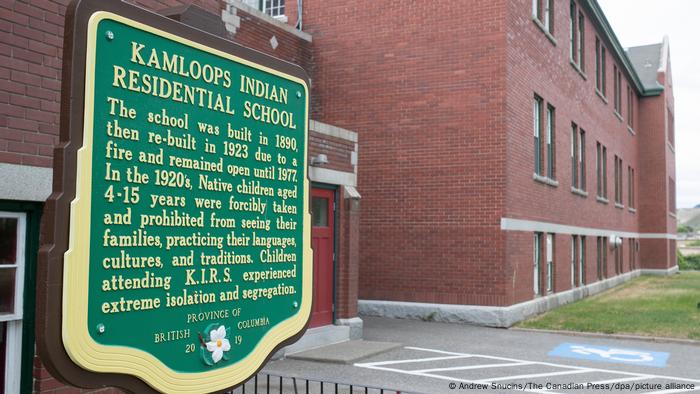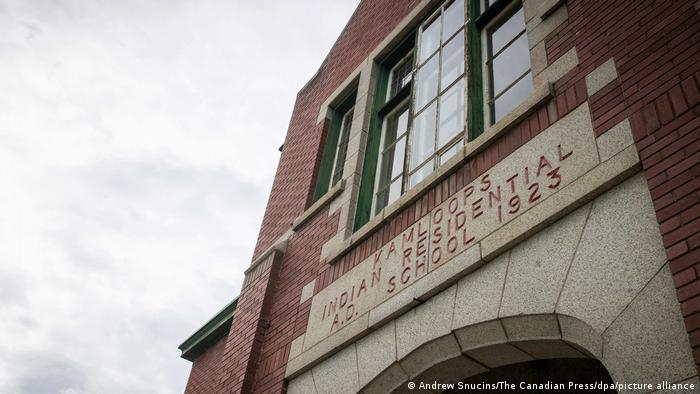Canada's First Nations Residential School System
"In many cases, school principals simply reported on the number of children who had died in a school, with few or no supporting details.""[Despite this; many of the schools built so poorly they were virtual fire traps], for much of their history, Canadian residential schools operated beyond the reach of fire regulations."Report, Truth and Reconciliation Commission
 |
| A sign tells how Kamloops pupils were forbidden from seeing their families, practicing their languages or traditions |
In the 19th Century, the then-government of Canada in consultation with religious groups put together a plan to gather aboriginal children from their tribes, take them from their families -- in their best interests to achieve a 'civilized' education which would enable them to take their place as model citizens, joining the rest of Canada, rather than have them remain on reservations learning traditional culture, language, way of life as a means by which these children would be 'westernized' and 'civilized', and learn how to look after themselves as they integrated into the broader society.
This was accomplished by government fiat; no consultation with tribal authorities, much less seeking permission from the parents whose children would be scooped up and taken to the nearest residential school to be taught as the government saw would best fit their plans for future integration; to make 'Canadians' out of First Nations children. The children certainly weren't consulted, much less their parents and it's clear that neither the children nor their parents would have given consent.
Many of the children suffered through their years at the residential schools, many others learned skills that would serve them in later life, and they bore no ill-will toward the program. Many others, however, felt they were deprived of their First Nations childhood and many among them experienced harsh treatment while at the schools; punishment meted out to children who rebelled. Without doubt all the children involved missed their families and their tribal way of life.
When childhood diseases swept through the country in the late 1800s and mid-1900s, the toll among children was inevitable until vaccines and other therapies were produced to save lives. At the residential schools where children lived closely with one another the infection rate among the residents was higher and comparatively many more children died than in the broader community. There was little-to-no communication between the authorities at the residential schools and the parents of the children.
 |
| Delhia Nahanee from the Nisga'a and Squamish First Nations lays a rose on one of 215 pairs of children's shoes on the steps of the Vancouver Art Gallery |
The presence of fair-sized cemeteries on the property of the residential schools has always been a rallying point for First Nations activists and leaders demanding the end of the residential schools, compensation to past residents, and apologies for the heavy-handedness of depriving families of their children. Outside of Kamloops, British Columbia 215 unmarked graves belonging to children resident at the Kamloops Indian Residential School were discovered this week.
Chief Harvey McLeod of the Upper Nicola Band recalled his own experience at the school as a child. "I just remember that they were here one day and they were gone the next", he said of seeing his schoolmates disappearing and never being spoken of afterward. The government appointed a committee in 2008 to look into the simmering issue of the residential schools. The Truth and Reconciliation Commission produced a damning report detailing the ways in which thousands of First Nations children suffered hardship living away from their parents, many of them never to return.
The commission put the number of children who had died while attending a residential school at 3,200; one in every 40 students throughout the 120-year existence of the schools. Most of the schools had graveyards sitting adjacent the school buildings; many of the graves were unmarked, records never kept of children's names, tribes, ages; their parents obliquely notified but given no details, and never was the body of a child sent back to his/her parents for burial and the ritual of mourning.
"It's staggering to think that families would not have known what happened to a child that was sent off to the residential schools", noted Ontario;s Chief Coroner in 2012 when his office initiated an inquest into unrecorded residential school deaths. When a mother near Cornwall, Ontario heard of her son's death at residential school as a result of meningitis, she requested his body be returned home for burial. "It is not the practice of the Department to send bodies of Indians by rail excepting under very exceptional circumstances", the Department of Indian Affairs responded.
Tuberculosis was the most prolific killer of the children. Negligent health practices and cramped conditions made residential schools hotbeds of infection. The years 1870 to 1920 were the deadliest years at the Indian Residential Schools. Opened in 1884, the first six years of the Qu'Appelle Indian Residential School saw over 40 percent of its students die. In southern Alberta, the Sacred Heart Residential School had an annual student death toll of one in 20.
As late as the 1940s, the death rates at residential schools were up to five times greater than among Canadian children as a whole. Nearly one third of the students at the Kuper Island Residential School located in British Columbia died in the years following its 1889 opening. "The Indians are inclined to boycott this school on account of so many deaths", a school inspector wrote in 1922.
There was a marked absence of the most basic of medical care at the residential schools. James Gladstone who became the first Status Indian appointed to the Senate of Canada, wrote in his memoirs of a fellow student who died when no medical attention was given the boy after he stepped on a nail. "I looked after Joe for two days until he died. I was the only one he would listen to during his delirium", wrote Gladstone.
Poor construction and the lack of basic safety standards led to residential school fires with mass-casualty incidents. A fire in 1927 at the Beauval Indian Residential School in Saskatchewan led to the death of 19 students. Three years after that 12 students died at Cross Lake Indian Residential School in Manitoba when a fire broke out there.
And then there was the sad reality of children attempting to run away from the schools in hopes of reaching their homes. On these occasions when children ran away, the schools appeared to make little effort to recover the children by launching search parties. On New Year's Day, 1937 a group of four boys aged 7 to 9 ran away from Fraser Lake Indian Residential School with the intention of reaching their families at the Naldeh reserve seven miles' distance.
When the school eventually assembled a search party, the boys were found frozen to death less than a mile from home, 24 hours after they had run off. With this latest discovery of 215 undocumented graves of children, Chief Rosanne Casimir of the Tk'emlups te Seewepeme First Nation revealed that a ground-penetrating radar specialist had aided in the location of the graves. Speaking of the discovery as an "unthinkable loss that was spoken about but never documented at the Kamloops Indian Residential School".
 |
| Researchers found the remains of at least 215 Indigenous children on the property of the former Kamloops Residential School |
Labels: Canada, First Nations, Indian Children, Residential Schools

0 Comments:
Post a Comment
<< Home